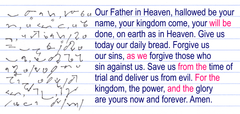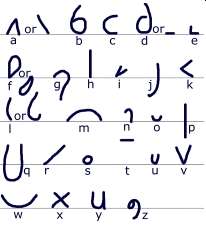Teeline Shorthand
Teeline is a shorthand system developed in 1968 by James Hill,[1] a teacher of Pitman Shorthand.[2] It is accepted by the National Council for the Training of Journalists, which certifies the training of journalists in the United Kingdom.[2]
| Teeline Shorthand | |
|---|---|
 | |
| Type | semi-script abjad Stenography
|
| Languages | English |
| Creator | James Hill |
Time period | 1968–present |
Child systems | - |
It is mainly used within the Commonwealth, but can be adapted for use by Germanic languages such as German and Swedish. Its strength over other forms of shorthand is fast learning, and speeds of up to 150 words per minute are possible,[3] with it being common for users to create their own word groupings, increasing their speed.[2]
Writing style
Teeline shorthand is a streamlined way to transcribe the spoken word quickly by removing unnecessary letters from words and making the letters themselves faster to write.[2] Vowels are often removed when they are not the first or last letter of a word, and silent letters are also ignored.[2] Common prefixes, suffixes, and letter groupings (such as "sh" and "ing") are reduced to single symbols. The symbols themselves are derived from the old cursive forms of the letter and the unnecessary parts are again stripped leaving only the core of the letter left.[2] Unlike phonetics based shorthands, such as Pitman, Teeline is a spelling based system.
Alphabet

Teeline differs from many shorthand systems by basing itself on the alphabet as opposed to phonetics, making it simpler to learn but also carrying the speed limitations of the alphabet when compared to other systems.[2] However, it is common to find some phonetics spellings used. For example, ph is often just written as an f, so the word phase would be written as if it were spelt fase. This coincides with the creator's intentions of streamlining it as much as possible.[2] As with many shorthand systems, there are few strict rules on how to write it, so it is common for users to make personal adaptations for their own use.[2] Certain letters also have specific meanings as well as their traditional alphabetic value, as shown in the table below.
Note: there may also be some regional, dialectal, and linguistic additions to these.
| Letter | Meaning | Notes |
|---|---|---|
| A | auto, after, able, able to, ability | Can also be used as an outline for "Blood Group A". There is also an indicator A for words ending in "Ang", but indicators can be used for word beginnings. |
| B | bee, be | Can also be used for "blood group B". It can also be mistaken for a number 6, so all numbers 0–99 are circled |
| C | Local, locals, because (if below the line) | |
| D | Do, Day | T & D are parallel lines, but T can be dropped in certain cases. T goes at the top of the line and D goes to the bottom. |
| E | Electricity | Also used as an indicator for words spelled with "eng" |
| F | From | |
| G | Go, Gentleman | |
| H | He | Written on the line, so it's not mistaken for a "P" |
| I | I (singular), Eye | Also used as indicator I and words spelled with "Ing" |
| J | None | Can be given a meaning, Just |
| K | Kilo, Kind, Like | |
| L | Letter, Lady, a lot, a lot of | Upwards L can be used as an outline for facilities. Sharp "L" used before a G, M and N, upwards L afterwards. |
| M | Me, May | |
| N | Non, Nation, National, Begin, Beyond | Begin/Beyond are written below the line but Non, Nation and National are special outlines that use a special N (looking like an upside down Q). Also used in the T position to denote words ending in "ion", such as "junction". |
| O | Blood, bloodspot, pint of blood, or | Outline for "Blood" derived from blood groups, meaning that A, B and O can be used as an outline for each blood group. Also used as an indicator for words spelt with "ong" and "ology", so sociology would be written as "S,C, disjoined O". |
| P | Page, Pence, Police | Can be blended with H to form word groupings with "At The post office" or "in the post", "In the Past" |
| Q | Queen, question, equal | |
| R | Are, authority | |
| S | South | |
| T | to, too | |
| U | You | Indicator used for words ending in "ung" and beginning in "un" |
| V | Very, Evidence, evidently | "Evidence" and "Evidently" are written below the line |
| X | Accident, accidentally | Can also be used for "Christ", "Christian", etc. Cf. X for "Christ" |
| Y | Your, Why | |
| Z | Zoo, Use | Can be replaced with an S |
| SH | shall, shell | represented as a longhand letter S and can be used in words like "special" or "social". |
| CH | Chair(man/woman) | |
| TH | The, Thousand(s) | Can be used in word groupings like "At The", "in The", etc., by putting the "At" or "in" in the T position. |
Writing technique
Teeline eliminates unnecessary letters, so that the remaining letters can be written in one swift, sweeping movement. People who use it daily will run words together: proficient users develop their own forms for common phrases, such as "more and more people" and "in the end".[4]
It is possible to write most words using basic Teeline theory, which consists of the alphabet and vowel indicators, but learning advanced Teeline theory allows users to increase their speed to well in excess of 100 words per minute.
Examples of Teeline theory include blending of letters (such as CM, CN and PL) and the R principle.
Doubling is also commonly used in Teeline - this involves lengthening the outlines for D, T, L, M and W to indicate that an R comes after these outlines - for example, the "D" outline becomes "DR" when it is lengthened, and "M" becomes "MR".
Speed can be dramatically increased through the use of reduced suffixes and prefixes that occur frequently, such as "under-", "multi-" and "trans-", along with "-nce", "nch", "-able" and "-ing".
Notable users
Alastair Campbell used Teeline to write his diaries while serving as spokesman for UK Prime Minister Tony Blair.[5] He has claimed to have 120 wpm ability.[6] Campbell's tutor later reported that he was first in his class, reaching 100 wpm before others. But political pundit Roy Campbell-Greenslade has questioned the value of shorthand in the digital era, noting an instance where a reporter's scrawl could not be read by a court-appointed Teeline expert.[7] British MP Meg Hillier has said she wields Teeline at 100 wpm and is wary of any reporter who fires questions at her faster than she herself could jot down.[8] Jon Harris of Cavendish Press says training programs that omit Teeline are short-changing their trainees. "Shorthand makes for a more rounded reporter; yet without it some of these courses are just 'Del Boy' degrees," he told the UK Press Gazette.[9]
In popular culture
Teeline appears on the cover of the album The Gaelic Chronicles by The Budapest Cafe Orchestra.[10] Fiddler Christian Garrick said he was astounded to find a reporter using shorthand during an interview and asked her to scrawl the words for the album cover.[11]
Teeline is referenced in "A Way to Grieve," the fifth episode of the second season of the television show Hanna (TV series), as a journalist's method for keeping notes that cannot be easily read by others.
References
- Hill, James (1968), Teeline: a method of fast writing, London, Heinemann Educational, OCLC 112342
- Bowers, Meriel; Clarkson, Jean; Hall, Stephanie; Osborne, Celia; Parkinson, Ulli (1991). Teeline Gold (The Course Book) (1 ed.). Oxford: Heinemann Educational. ISBN 0-435-45353-X.
- www.pressgazette.co.uk Archived 2011-06-16 at the Wayback Machine, Reporter breaks shorthand record
- "News agency boss says journalism degrees which don't offer shorthand are 'Del Boy' courses – Press Gazette". www.pressgazette.co.uk. Retrieved 2017-03-10.
- "Interview: Alastair Campbell, former spin doctor to Tony Blair". www.scotsman.com. Retrieved 2017-03-08.
- Campbell, Alastair. "On the perils of shorthand and/or mumbling and/or not fully explaining". www.alastaircampbell.org. Retrieved 2017-03-08.
- "The shortcomings of shorthand". The Guardian. 2010-12-08. ISSN 0261-3077. Retrieved 2017-03-08.
- "You will want to learn shorthand after reading this post". Wannabe Hacks. 2010-12-02. Retrieved 2017-03-08.
- "News agency boss says journalism degrees which don't offer shorthand are 'Del Boy' courses – Press Gazette". www.pressgazette.co.uk. Retrieved 2017-03-10.
- McKenzie, Steven (2016-05-17). "'Granny's Gaelic' inspires Budapest Cafe Orchestra". BBC News. Retrieved 2017-03-08.
- McKenzie, Steven (2016-05-17). "'Granny's Gaelic' inspires Budapest Cafe Orchestra". BBC News. Retrieved 2017-03-08.